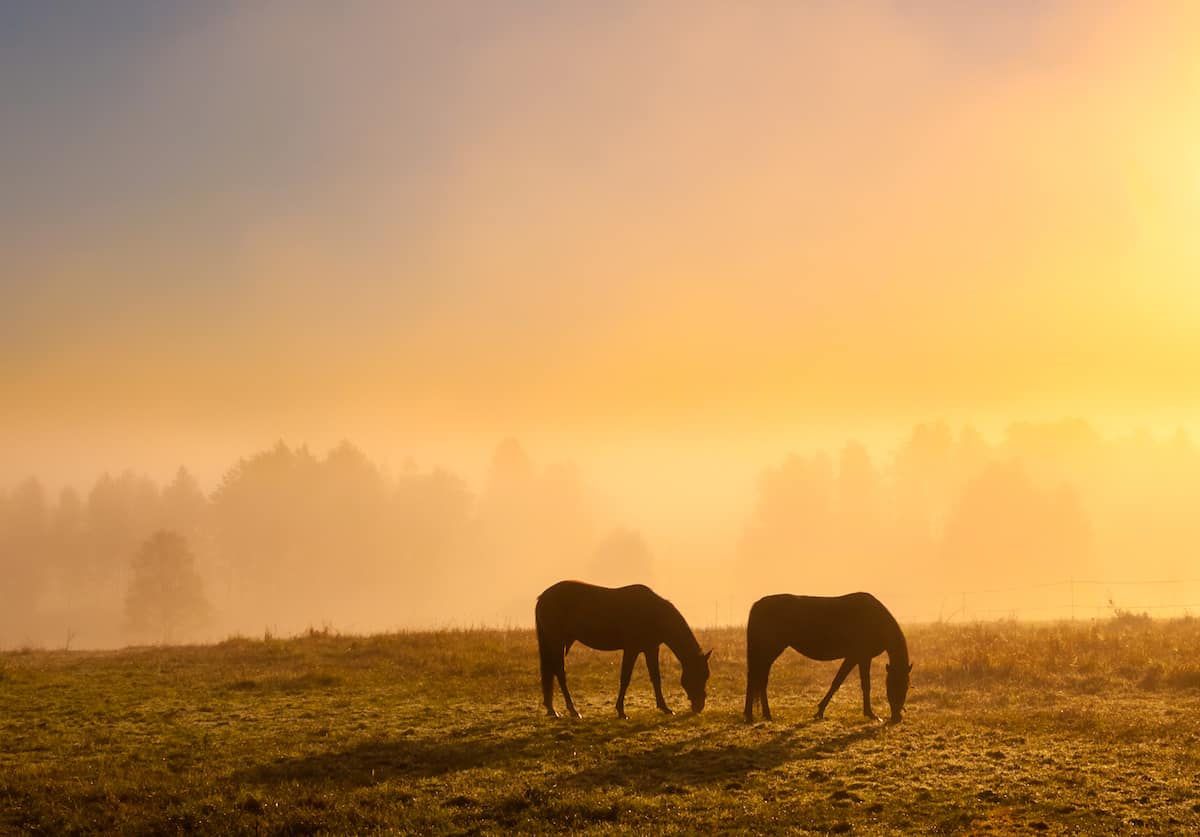The transition off the track can leave Thoroughbreds susceptible to opportunistic skin diseases

Many OTTBs coming right off the track haven’t been exposed to mud and wet grass recently, so with turnout they’re at risk of developing skin issues such as dermatitis. Courtesy istock.com
Thoroughbreds are known for their sensitive nature, both mentally and physically. Some might assume this means they also have extra fragile skin, an easy explanation as to why OTTBs can struggle with dermal diseases such as scratches and rain rot. That, however, isn’t necessarily the case. “But it can definitely seem that way,” says Elizabeth Arbittier, VMD, an assistant professor at the University of Pennsylvania School of Veterinary Medicine’s New Bolton Center, in Kennett Square. Instead of breed predisposition, she says, OTTB skin challenges are likely linked to environmental and management changes, as well as the stress the horses experience transitioning from the track to their new careers.
“Many OTTBs who are adopted right off the track aren’t currently spending much time exposed to the elements in turnout, so they haven’t been in mud, tall and wet grass and rain, which are all predisposing situations for dermatitis,” she adds. “Another predisposing factor for dermatitis is immune suppression, so horses that are stressed or receiving some medications may be more susceptible to recurring skin issues until their immune system rebounds.”
Once many of the microbes responsible for skin diseases move into an OTTB’s skin, they can prove difficult to evict.
Speaking of microbes, a variety of bacteria, viruses and fungi can contribute to skin issues. Before you can effectively treat your OTTB, you’ll need to work with your veterinarian to figure out what you’re fighting. Veterinarians will make most skin crud diagnoses via visual examination; however, sometimes cultures are necessary to target treatment. The following are some of the most common skin conditions your OTTB might experience while transitioning off the track.
Scratches
This condition has several other common names, including equine pastern dermatitis, dew poisoning, greasy heel or mud fever. All describe itchy, flaky, sometimes sticky skin, usually on the horse’s lower leg, along the heel or the cannon bone. Scratches is caused by opportunistic bacteria, fungi or viruses that typically thrive in wet and/or unsanitary conditions. Breaks in the skin can allow these microbes to move in. Horses in excessively wet or muddy environments are at greater risk of getting scratches. Untreated, it can turn into cellulitis (a serious infection of the subcutaneous tissues that lie beneath the skin), Arbittier says.
Treatment: Keep your OTTB’s legs dry; house him in a dry, clean area; and wash with antimicrobial shampoos pH-balanced for horses. Shaving hair off the area can also help. Because scratches is notoriously hard to treat, many veterinary clinics mix and sell their own topical treatments, which include barrier elements (to protect the skin), antibiotics and steroids, Arbittier says.
“Don’t overscrub dermatitis, which can cause it to flare into a cellulitis,” she adds. “I prefer applying a thick coating of scratches ointment and wiping it off twice daily to reapply, taking the scabs with it. This softens and loosens the scabs without inflaming the skin and allows the ointment to work on the skin.”
General Dermatitis
While the term “scratches” describes dermatitis on the legs, dermatitis can occur on other parts of the body, including the chest, behind the elbow or along the girth. It’s typically easier to treat than scratches, because the affected areas are easier to keep dry than a horse’s legs (which are often in dewy grass or mud).
Treatment: Treating general dermatitis is similar to treating scratches — try antimicrobial shampoos and topical treatments. Management changes, such as grooming and blanket sanitizing, can also help. “If someone takes off a blanket that hasn’t been removed for a while and realizes that there is dermatitis underneath, simple currying and letting air get to it frequently will fix it,” Arbittier says. “The longer things go and the more chronic they are, the more damaged the skin gets and the harder it can be to fix. That said, as long as cellulitis doesn’t set in, even chronic dermatitis can generally be fixed with dramatic management changes. I reach for systemic antibiotics when a horse has generalized dermatitis that has gone untreated for a while or focal dermatitis (such as scratches) that isn’t healing. I’ll also start systemic antibiotics if a horse has an acute dermatitis that has been scrubbed/clipped and has flared into a cellulitis. If antibiotics don’t help, I will biopsy an area to better understand what is going on.”
Rain rot
Also known as rain scald, this skin condition is caused by the Gram-positive bacterium Dermatophilus congolensis and is most common in horses (as well as cattle and other animals) that live in wet environments. D. congolensis is commonly believed to live in the soil and has been found on the skin of both animals and people. The bacterial infection causes small to large scabs of raised, matted tufts of hair to appear along the horse’s neck, withers, back, croup and sometimes lower limbs. As the lesions grow, they join together and form large crusts or scabs.
It can spread through contaminated equipment (i.e., brushes, blankets, shared tack) and by biting insects.
Treatment: Sheltering the horse from its wet environment, shampooing with an antibacterial shampoo pH-balanced for horses and treating with a topical antibiotic are the first steps to treating the infection. Soften and gently remove rain rot scabs or “crusts,” because they can harbor the bacteria. Also isolate animals with rain rot so the disease doesn’t spread. Disinfect their grooming supplies, and avoid using them on other horses. In some instances your veterinarian might treat your OTTB with antibiotic injections.
Ringworm
Ringworm is an extremely itchy skin condition that actually has nothing to do with worms. Instead, it’s caused by highly contagious fungi, many of which can be spread between species (e.g., cats, dogs, horses, humans). These fungi create rings of hair loss with raised centers.
Treatment: Treating ringworm requires consistent use of targeted antifungal shampoos and topical treatments. Your veterinarian can help you select the most effective antifungal product, and prescription strength might be necessary. Isolate affected horses from other horses and animals, such as dogs and cats, and disinfect their grooming supplies and equipment after use. Wash your hands thoroughly after handling or treating a horse with ringworm, and keep in mind that you could catch it, as well.
Prevention Is Better Than the Cure
While the equine skin conditions included here are rarely life-threatening, they are uncomfortable for the horse and inconvenient and time-consuming for the humans treating them. Arbittier recommends being proactive in preventing them, especially as your OTTB transitions from the track to his new life.
“I find that management is often the critical factor when people get horses off the track and end up with a lot of skin problems,” she says. “Many OTTBs can’t immediately go onto 24/7 turnout or turnout in the mud, wet grass and bugs.”
Instead, make sure your OTTB has adequate shelter from wet weather and a place to get out of the mud, says Arbittier. Keep his paddock free of manure, and consider pasture turnout only after the morning dew has dried. Feed him a balanced diet to help support his immune system, and work to reduce his stress during transition.
“Sometimes it’s not about lotions and potions but about management,” she says.
Insect Hypersensitivity
Skin allergies to biting insects can also cause raised skin and oozing wounds. Besides making the horse itchy and miserable, when left unmanaged those wounds can make an allergic Thoroughbred’s skin susceptible to opportunistic microbes that move in when skin is damaged.
“OTTBs may be really unhappy when turned out in the bugs, because they just aren’t used to them,” says Elizabeth Arbittier, VMD, an assistant professor at the University of Pennsylvania School of Veterinary Medicine’s New Bolton Center, in Kennett Square. “Then they run and get sweaty and cause all sorts of other problems with their skin, feet and legs. True insect hypersensitivity in horses is an allergy to the saliva of the insects and can be very challenging to manage, although there are some interesting ideas on the horizon, including a vaccine.”
Just like in humans, allergies have no cure, but they can be managed. Strategies include:
■ Outfitting your OTTB with a flysheet to create a barrier between his skin and biting insects.
■ Applying fly spray.
■ Eliminating insect habitats, especially standing water or wet or muddy areas.
■ Picking up manure and keeping your OTTB’s home sanitary.
■ Housing horses inside during dawn and dusk, when insects are most active.
■ Using a stall fan to knock down flying insects.
■ Talking to your veterinarian about using steroids and antihistamines to manage clinical signs.
■ In some cases, allergy shots — ask your vet whether these might be helpful.

